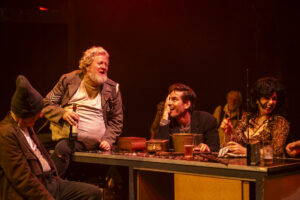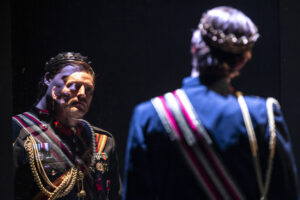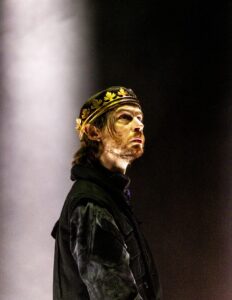York Theatre, Seymour Centre, March 29
8.5/10
The great wonder of history is that we continue to be surprised by it unfolding in our own lifetimes, as if it were something that only happened in the past. The corollary is that all that happened in the past is our tutor if we’ll listen – hence part of the longevity of Shakespeare’s eight history plays, despite only a couple of them being among his greatest works.
Linking the eight – Richard II, the two parts of Henry IV, Henry V, the three parts of Henry VI and Richard III – into a chronological cycle is a fond project of bardologists, this being Sydney’s third this century. Immediately setting The Player Kings apart from The War of the Roses (2009) and Rose Riot (2018) is its sheer scale. Including the intervals, this was 12 hours long: a monumental demand upon audiences, actors and technicians. Within that frame, the director and adaptor, Sport for Jove’s Damien Ryan (who also did Rose Riot), has succeeded in emphasising narrative through-lines, intergenerational parallels, clarity of language and the plays’ contrasting worlds.

The show’s presented in six chapters of towards 90 minutes each, knitted by such devices as having Falstaff, beloved joint protagonist of Henry IV, cheekily appear before the preceding Richard II is done. Ryan cunningly fiddles with the order of events and placement of speeches, without doing any particular disservice to Shakespeare.
Yet, despite the care with which the plays have been edited and the general excellence of the performance, it’s simply too long, and the problem, as ever, is Henry VI. The young Shakespeare contributed to these three plays rather being their primary creator (who probably was Christopher Marlowe), and consequently much of the verse is inferior, the characterisations are thin and the storylines mere bloody melodramas. Henry VI essentially consumed two Player Kings chapters: a massive edit of three full-length plays, but still a drag upon the whole because it’s too burdened with the tiresome bickering of the ruling class – or what we now call politics.
We tumble into the concluding Richard III, therefore, with some relief, and it’s fully worth the wait because Liam Gamble is as good a Richard as I’ve seen. Having cerebral palsy, and therefore not fully able-bodied himself, Gamble evades the cartoonish Richards that have predominated. Any good performance of Richard charms us, as he smirkingly confides in us his wicked plans, but Gamble makes our emotional response to Richard more complex; draws us towards him in a way that changes the dynamics of the play. We aren’t just charmed by his Richard in a sly, winking sense; we’re charmed to the point of being won – until, of course, his outrageous bloodlust snaps our new-found tolerance.

Steve Rodgers presents a memorably likable rogue of a Falstaff. The prodigious Sir John has been portrayed as more intelligent or sadder, but seldom as more fun, amid which Rodgers still mines the deep truths of his speech about the speciousness of honour. He later returns as the rabid Jack Cade in Henry VI, and all 17 performers take many roles, other than composer Jack Mitsch primarily realising his own score on drums, guitar or keyboard; a score that makes the most dramatic episodes thunder, delicately shades others, and never tramples on the language.
Inevitably with people playing multiple roles, there’s some unevenness, although veterans Peter Carroll and John Gaden are uniformly good, including when playing Silence and Shallow to Rodgers’ Falstaff. Gaden is a noble John of Gaunt in Richard II, and Carroll clowns his way through the put-upon waiter Francis in a lively Henry IV scene.

A hallmark of Ryan’s directing is the never-laboured, yeast-like visual humour he adds to his brew, whether as the merest grace notes or as fizzing embellishments from his arsenal of surprises. His son, Max Ryan, excels as a swaggering, live-wire Harry Hotspur in Henry IV, while Max’s brother Oliver plays Harry’s counterpoint, Prince Hal, and their fraternal swordfight sees sparks flying from their blades.
Ryan’s direction crafts countless moments of magic, such as Hal looking in a mirror where the reflection is enacted by Andrew Cutcliffe, who then becomes Hal as he’s crowned Henry V, encapsulating the change in personality. Cutcliffe’s Henry is defined by a lighter, more intimate and slightly comedic St Crispin’s Day speech.
Another piece of magic comes when Ryan has a troop of English soldiers undergoing a medical examination become the members of the French court in a sauna via a sudden flourish of towels. That said, there are also moments when the French characters seem inclined to the Monty Python school of accents.

Katrina Retallick shines as a wildly loyal and impassioned Isabel, wife to Ricard II, played by Sean O’Shea, who leads us on that character’s agonising journey from royal petulance to confronting his mortality and what would be his ordinariness, were he not a poet whose exquisite lyricism intensifies as his power drains away.
Gareth Davies, Emma Palmer (a hilarious Doll Tearsheet), the stentorian-voiced Christopher Stollery, Marty Alix, Lulu Howes, Leilani Loau and Ruby Henaway all have their moments in the sun, with the latter playing Joan of Arc, the most intriguing creation in Henry VI. The crackles of the flames when she burns are created by the actors clapping out of synch.
Immeasurably aided by Kate Beere’s set (with 20th-century costumes) and Matt Cox’s lighting, much of the production is so enthralling that at one point in I was momentarily stunned to see other audience members in the light. We all stood and cheered at the end, knowing the actors, guided by Ryan’s vision, had just pulled off a triumph of the will as well as of their art, and we, the audience had been just been part of a tiny slice of history. Nonetheless, see it over two days rather than one.
Until April 5.